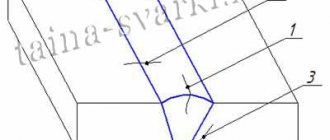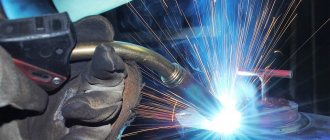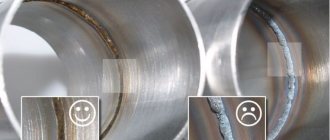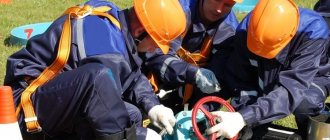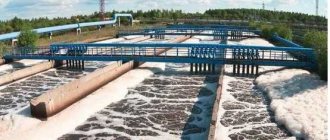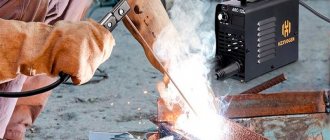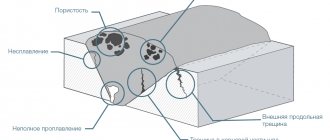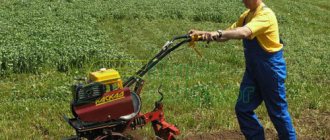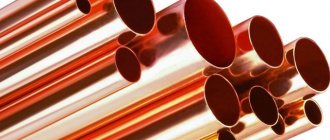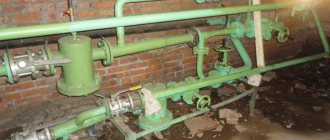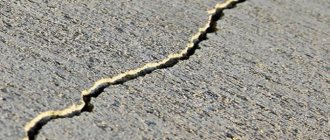Classification of stresses and strains
Depending on the cause of their occurrence, intrinsic stresses are divided into:
- thermal stresses - appear as a result of uneven temperature distribution during welding;
- structural stresses - appear as a result of transformation of the structure during heating above the critical temperature.
Depending on the time of existence, the natural stresses are:
- temporary - exist during certain phase transformations and disappear upon cooling;
- residual - remain even after the disappearance of the reasons for their formation.
Depending on the area of action, three types of voltages are distinguished:
- stresses that act in the volumes of the structure;
- stresses that act within the grains of the metal;
- stresses that exist in the crystal lattice of a metal.
According to the direction of action of stress and deformation, there are:
- longitudinal - along the axis of the weld;
- transverse - directed perpendicular to the axis of the seam.
Depending on the type of stress state, there are:
- linear - act in one direction;
- planar - act in two directions;
- volumetric - act in three directions.
Stresses can also be compressive or tensile.
Deformation is called general if it changes the size of the entire product, and local if it changes part of the product.
Deformations can be plastic and elastic. If the structure restores its shape and size after welding, then such deformation is called elastic, and if it is not restored, it is called plastic.
During welding of structures, stress and deformation occur. Stress that exceeds the yield limits of the metal leads to the appearance of plastic deformations that change the size and shape of the structure. Stresses exceeding the strength limit leads to the appearance of cracks.
Lithology. Structural geology
The curve is divided into three sections: ab - decaying creep rate; bv - steady (uniform) speed and vg - increasing speed; the last section ends with the destruction of the material at point r . Section Oa represents the deformation (mainly elastic) at the moment of loading. Sections ab, bv and cd, corresponding to plastic deformation, are called the first, second and third stages of creep. Creep is explained by the fact that during plastic deformation, hardening occurs, as a result of which further plastic deformation should stop. However, under the influence of elevated temperature, softening occurs over time. At the first stage, hardening prevails over softening.
In polycrystalline materials, this is due to the fact that the stresses in individual crystals of each section of the body, which are unequal at the moment of loading, due to anisotropy, are leveled across the section during plastic deformation. At the second stage, the rates of hardening and softening become equal, and deformation proceeds at an approximately constant rate. At the third stage, which often begins with the formation of a compaction (neck) in the body or with a decrease in the effective cross-section due to the formation of cracks (the initial appearance of which usually dates back to the second stage), the stress in the corresponding places quickly increases, which leads to accelerated deformation and destruction . There is another explanation for the creep process, when it is considered as a simple flow of material caused by the relative movement of atoms and molecules.
Relaxation and creep essentially reflect one process, which consists in a gradual decrease in the intensity of the internal elastic forces that arise in the body when a load is applied due to the development of plastic deformations, which occurs quite slowly. Relaxation and creep play an extremely important role in the geological environment, providing the possibility of the slow development over millions of years of large plastic deformations in the earth's crust under the influence of not too great forces.
The ability of a body to deform under its certain mechanical properties depends on a number of conditions. Such conditions are primarily: the nature of external forces, temperature, solutions, confining (hydrostatic) pressure, deformation rate .
The nature of external forces determines the ratio of tangential and normal stresses and the signs of the latter. In particular, for plastic deformation, compressive forces are more beneficial than tensile forces (a compressed body is less brittle than a tensile body).
An increase in temperature leads to an increase in the plasticity of solids. Creep is associated with high temperature. The action of solutions and water vapor also increases the plasticity of solids (rocks). In the presence of a liquid or gas-liquid phase in deformed rocks, recrystallization or dissolution of some minerals and the formation of new ones occur especially vigorously.
Confining pressure, on the one hand, increases the resistance of the body to plastic deformation - to achieve the same deformation at greater confining pressure, greater stress is required; on the other hand, it increases their ability to deform plastically for a long time without destruction. For example, limestone under atmospheric pressure experiences only elastic deformations and breaks immediately beyond the elastic limit, without having time to undergo even subtle plastic deformation. Under a uniform pressure of 10,000 atm, the same block of limestone stretches plastically to 50% of its original length.
An increase in the strain rate leads to a decrease in ductility (increases brittleness). Reducing the strain rate increases plasticity (fluidity, creep).
In general, in a geological setting, the greatest influence on the properties of rocks seems to be exerted by the time factor. It is he who, presumably, transforms the phenomena of relaxation, fluidity and creep in the conditions of the earth's crust in such a way that sandstones and limestones, hard and brittle under normal conditions, are capable of bending plastically into very complex folded complexes.
Causes of stress and deformation
Structural transformations
When welding alloy and high-carbon steels, structural transformations often occur in the metal - the size and arrangement of metal grains change during cooling. Therefore, the initial volume of the metal changes and internal stresses arise.
Uneven heating
Rice. Uneven heating of the metal
When heating a metal rigidly bound to a cold metal, compressive and tensile stresses are formed. This is due to the change in the dimensions of the metal when heated.
Foundry shrinkage
Casting shrinkage of molten metal is accompanied by a decrease in the volume of the metal during its crystallization. Since the molten metal is connected to the base metal, longitudinal and transverse stresses arise under the influence of casting shrinkage.
Rice. Deformations due to transverse shrinkage
Rice. Deformations due to longitudinal shrinkage
Methods for counteracting stress and strain
Pre- and post-heating
Preliminary and accompanying heating of steels improves the mechanical qualities of the weld and adjacent zone, reduces plastic deformations and residual stresses. Used for steels prone to hardening and the formation of crystallization cracks.
Reverse step order of sutures
Rice. Reverse step order of sutures
Long seams (over 1000 mm) are divided into sections of 100-150 mm and each of them is carried out in the opposite direction to the welding direction. Using a reverse stepwise order of sutures, you can achieve more uniform heating of the metal compared to sequential application. Uniform heating of the metal significantly reduces deformation.
Forging seams
Both heated and cold metal can be forged. Upon impact, the metal expands in different directions, which reduces tensile stress. Welding seams on metal prone to the formation of hardening structures are not forged.
Balancing deformations
The method consists in choosing such an order of sutures in which each subsequent suture creates a deformation counteracting the previous one. For example, alternating layers when welding double-sided joints.
Creating Reverse Warps
Parts are assembled for welding initially at a certain angle. When the parts are brought closer together during welding, the deformation decreases.
Rigid fastening of parts
To do this, use rigid fastening of parts in the conductors. The parts are secured during welding and are removed after cooling. The disadvantage is the possibility of internal stress.
Deformations of structures and the reasons influencing their occurrenceOrobinsky V.S., Vinnikova T.P., Kosygin E.V.
Any structure experiences deformations that arise due to the influence of various natural and anthropogenic (technogenic) factors on both the foundation and the structure itself. The accumulation of deformations leads to unacceptable changes—movements of buildings or individual parts of them, which complicates its normal operation and can even lead to partial or complete destruction.
Deformation of structures occurs in both horizontal and vertical planes and mainly depends on the displacement of earth masses at their base. Vertical deformations caused by the movement of a structure or its parts up or down are divided into settlements, subsidence, swelling and shrinkage, subsidence, lifting or bulging. Horizontal deformations cause horizontal displacements or shifts of a structure. The tilt of a structure is called roll.
The main natural factors causing deformation include:
— the ability of rocks to subsidence and landslides;
- heaving during freezing of water-saturated rocks and thawing of frozen ice-saturated rocks;
— changes in hydrothermal conditions (seasonal and long-term temperature fluctuations), rock moisture and groundwater levels.
The main anthropogenic factors include:
— influence of load from the structure;
— change in the bearing properties of rocks;
— errors made during design and construction;
— the impact of human economic activity (geological development, land reclamation, construction of new engineering structures, etc.).
With uniform precipitation, the strength and stability of structures does not decrease, but they significantly affect connections with communications and other structures. The effect of uneven settlements on a structure always creates additional stress in their structures and can be dangerous. Due to uneven deformations on a structure, rolls, deflections, bends, distortions, torsions and breaks in the structural elements of structures can occur. It is necessary to study and observe these processes. The most independent and objective method for determining the above processes is geodetic, which makes it possible to determine the plan-elevation position of a point, and therefore of the entire structure.
The main task of the created geodetic networks is to establish control over deformations, with the help of which the following tasks can be solved:
— operational
: based on the magnitude of the movements of the control points, the actual mutual movement of the elements of structures and the foundation is established, from which one can draw a conclusion about a possible dangerous (emergency) situation at the time of control;
— strategic
: based on the magnitude of the multi-temporal movements of control points, the trend of deformation of the structure is established and a forecast of the development of the situation can be made.
Observation of vertical deformations can be performed by geometric and trigonometric leveling, micro-leveling, hydrostatic leveling, photogrammetric methods, or combinations thereof.
The measurement of horizontal deformations is carried out using the following methods: cross-sectional observations, individual directions (notches), triangulation, trilateration, polygonometry, photogrammetry.
When monitoring the tilt of structures, one of the following methods or a combination of them is used: sighting, coordination, measuring angles or directions, photogrammetry, leveling, mechanical methods using inclinometers and plumb lines.
Activities preceding observations of deformations of the studied objects consist of studying the available geological data, topographic materials, previously performed observations at the object, choosing a method and observation scheme, choosing instruments, laying deformation marks and ground benchmarks, which should be located outside the zone of deformation and on bedrock, determining the cyclicity of observations and methods for processing the results obtained.
Experience shows that even an approximate forecast of uneven settlement of large structures leads to a great economic effect and to increased reliability of building structures.
